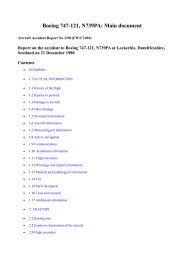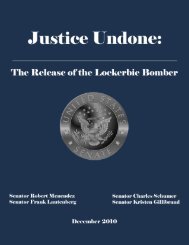REPORT OF THE - Archives - Syracuse University
REPORT OF THE - Archives - Syracuse University
REPORT OF THE - Archives - Syracuse University
You also want an ePaper? Increase the reach of your titles
YUMPU automatically turns print PDFs into web optimized ePapers that Google loves.
shortcomings in the screening of baggage, and of passengers, that could have contributed<br />
to the terrorist act that placed the bomb aboard the plane.<br />
Baggage Procedures<br />
The Commission has established that Pan Am in December 1988 did not reconcile the<br />
number of interline bags loaded into the belly of any plane leaving Frankfurt with the<br />
number of bags previously checked by the interline passengers who actually boarded the<br />
plane. Based upon Sonesen's "we go" advice from corporate headquarters in March 1988,<br />
Pan Am made no determination in Frankfurt whether a given interline bag ever had been<br />
checked in by any passenger.<br />
When Flight 103 backed away from the gate in Frankfurt, Pan Am security personnel did<br />
not know whether or not it was carrying an "extra" bag. If so, the bag continued right<br />
through Heathrow airport, where no further security control was applied.<br />
Records reviewed by the Commission suggest Flight 103 may well have carried at least<br />
one such bag. The operator of the X-ray machine for interline bags loaded onto Flight<br />
103 in Frankfurt maintained a detailed list of the bags X-rayed. The FAA agent, during<br />
the inspection in October 1988, had suggested to Pan Am that such a list be maintained<br />
precisely because Pan Am at Frankfurt had no verifiable tracking system for interline<br />
baggage.<br />
This list shows that 13 parcels (including two garment bags and a box appearing to<br />
contain six wine bottles) passed through the machine on the way to the flight. Other<br />
records, however, account for only 12 parcels (11 checked by passengers who boarded<br />
the flight and one so called "rush" bag of a passenger who had left on an earlier flight of<br />
another carrier).<br />
The Commission does not know whether a "thirteenth bag" loaded on Flight 103 in<br />
Frankfurt in fact contained the device that ultimately devastated Flight 103.<br />
If on December 21, 1988, the FAA or Pan Am had required that baggage could not be<br />
carried on any flight unless it was accompanied by a passenger, there now would be no<br />
question about an "extra" bag. No such bag would have been allowed on the plane. But<br />
that reconciliation procedure (without an exception even for physical search) was not<br />
required by the FAA or by Pan Am until after Flight 103 was destroyed and 270 lives<br />
were lost.<br />
If Pan Am in Frankfurt had at a minimum followed even the written requirements of the<br />
FAA in effect on December 21, there now would be no question about the contents of<br />
any "extra" bag. Those requirements called for physical search of any unaccompanied<br />
bags. If locked, a bag would not have been permitted to be loaded on the plane. If<br />
unlocked, a bag would have been physically searched.<br />
[PICTURE NOT INCLUDED]<br />
The wings and attached fuselage from Pan Am Flight 103gouged a crater 140 feet long<br />
and 40 feet wide.<br />
Finally, if on December 21, the FAA or Pan Am had required that baggage containers be<br />
secured at all times, there now would be no question about possible tampering with the<br />
container that sat open and unguarded for 30 minutes at Heathrow, waiting for the leg of










